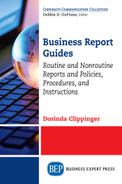Abstract, 131–132
Accuracy, 17
Action, in meeting minutes, 49
Agenda planning, 44–48
Agenda structure, 42–44
Backgrounder
company, 101–102
elements, 99–100
overview of, 98–99
writing guides, 103–104
Business form design, 4–6
Business form sources, 2–4
Business letter parts and sequence, 78–79
Business proposals
kinds of, 121–125
objective of, 120
proposal approval, 128–131
proposal content, 125–128
purposes of, 120–121
Cause-effect pattern, 11
Checklist
characteristics, 62
evaluating memos, 63
formatting e-mail reports, 63
general information, 64
for meeting agenda, 65–66
memo format conventions, 63
for PPP report, 65
Chronological pattern, 9–10
Clarity, 17
Combination patterns, 15
Company backgrounder, 101–102
Comparison and contrast patterns, 13–15
Compensation and benefits policy, 153
Completeness, 17
Conciseness, 17
Customer credit policy, 152
Customer quality policy, 152
Data-gathering method, 1
Deductive structure, 8–9
Degree of formality, 16
Direct structure, 8–9
Discipline policy, 153–154
Discussion, in meeting minutes, 49–50
Editing guides, effective, efficient, 195–197
Effective reports, qualities, 16–18
E-mail format, 23–25
Empathy, 16
Emphasis techniques, 21–22
Employee manual
advantages to employees and employers, 176–177
content guides, 177–180
design guides, 186–190
distribution and design of digital and paper manuals, 184–190
legal considerations, 180–184
overview of, 175–176
Employment policy, 152
E-signing, 131
Ethics policy, 152
Fact sheet
description of, 96–97
in infographic format, 98
in list format, 97
Feasibility report, 73–77
Flowchart, 154, 156
Focus group interview report, 72–73
Fonts, 19–20
Formal meeting minutes, 50
Formatting routine reports
overview of, 18–19
specific formatting guides, 22–27
text formatting guides, 19–22
Harassment and discrimination policy, 152–153
Headings, 22
Individual interview report, 70–72
Informal meeting minutes, 52–53
Internal reports, 2
Interview reports
focus group, 72–73
guidelines, 71–72
individual, 70–72
overview of, 69
IT policies and procedures, 153
Justification report, 75, 78, 83
Logical fallacies, 82
Manuscript format guides, 199–202
Marketing reports
business proposals, 120–131
overview of, 104–105
white papers, 105–120
Meeting agenda, 40–41
Meeting minutes, 48–61
after meeting, 58–60
categories of, 49–50
formal, 50
informal, 52–53
before meeting, 54–57
during meeting, 57
professional association’s meeting, 51
Meeting reports
agenda planning, 44–48
agenda structure, 42–44
meeting agenda, 40–41
overview of, 40
Memo format, 25–27
Monthly production report, 33
Nonroutine report, 1
Objectivity, 16
Operational proposal, 123–124
Organizational proposals, 123–124
Organization patterns
cause-effect pattern, 11
chronological pattern, 9–10
combination patterns, 15
comparison and contrast patterns, 13–15
problem-solution pattern, 10–11
spatial pattern, 11–12
topical pattern, 12
Organizing reports, patterns for, 62
Overview
characteristics, 133
examples, 132
of topic, 134–137
Paper forms, 2
Patterns for organizing reports, 62
Performance report, 30–34
Persuasive strategy, 79–81
Policies
basic guides for writing, 160–169
content, 169–170
significance of, 151–154
Poorly designed business form, 5–6
Press release
examples, 84
guides to writing, 88–92
standard components of, 87–88
structure and format, 85–86
Problem-solution pattern, 10–11
Procedures
basic guides for writing, 160–169
content, 170–171
importance of, 154–160
Production report, 30–34
Product proposals, 121–123
Professional association’s meeting, 51
Progress, plans, and problems (PPP) model, 36–40
Progress report
definition of, 34
progress, plans, and problems (PPP) model, 36–40
traditional model of, 34–35
Public relations reports
backgrounder, 98–104
fact sheet, 96–98
overview of, 82–83
press release, 84–92
video news release, 93–96
Purchasing policy, 154
Recommendation-based reports
feasibility, 73–77
justification, 75, 78, 83
Research proposal, 124–130
Routine reports
definition of, 1
formatting, 18–27
identifying, 27–61
Service proposals, 121–123
Short report. See Simple report
Simple report
definition of, 1
description of, 8
Social media news release (SMNR) report, 94–96
Spacing, 19
Spatial pattern, 11–12
Specific formatting guides
e-mail format, 23–25
guidelines, 23
memo format, 25–27
overview of, 22–23
Summation reports
abstract, 131–132
executive summary, 137–140
guides for writing, 139–140
overview, 132–137
Text formatting guides
emphasis techniques, 21–22
fonts, 19–20
headings, 22
spacing, 19
Tone, 15–16
Topical pattern, 12
Traditional model of progress report, 34–35
Trip (travel) reports, 27–30
Verbatim, 50
Video news release (VNR) report, 93–96
Well-designed business form, 7
White papers
best practices, 109–111
designing guides for, 118–120
guides for creating content, 111–117
guides to planning, 110–111
then and now, 105–109
Work instructions
basic guides for writing,
160–169
content and best practices, 171–175
importance of, 157–160
Workplace safety policy and procedures, 154
Writing style
degree of formality, 16
objectivity, 16
tone, 15–16
